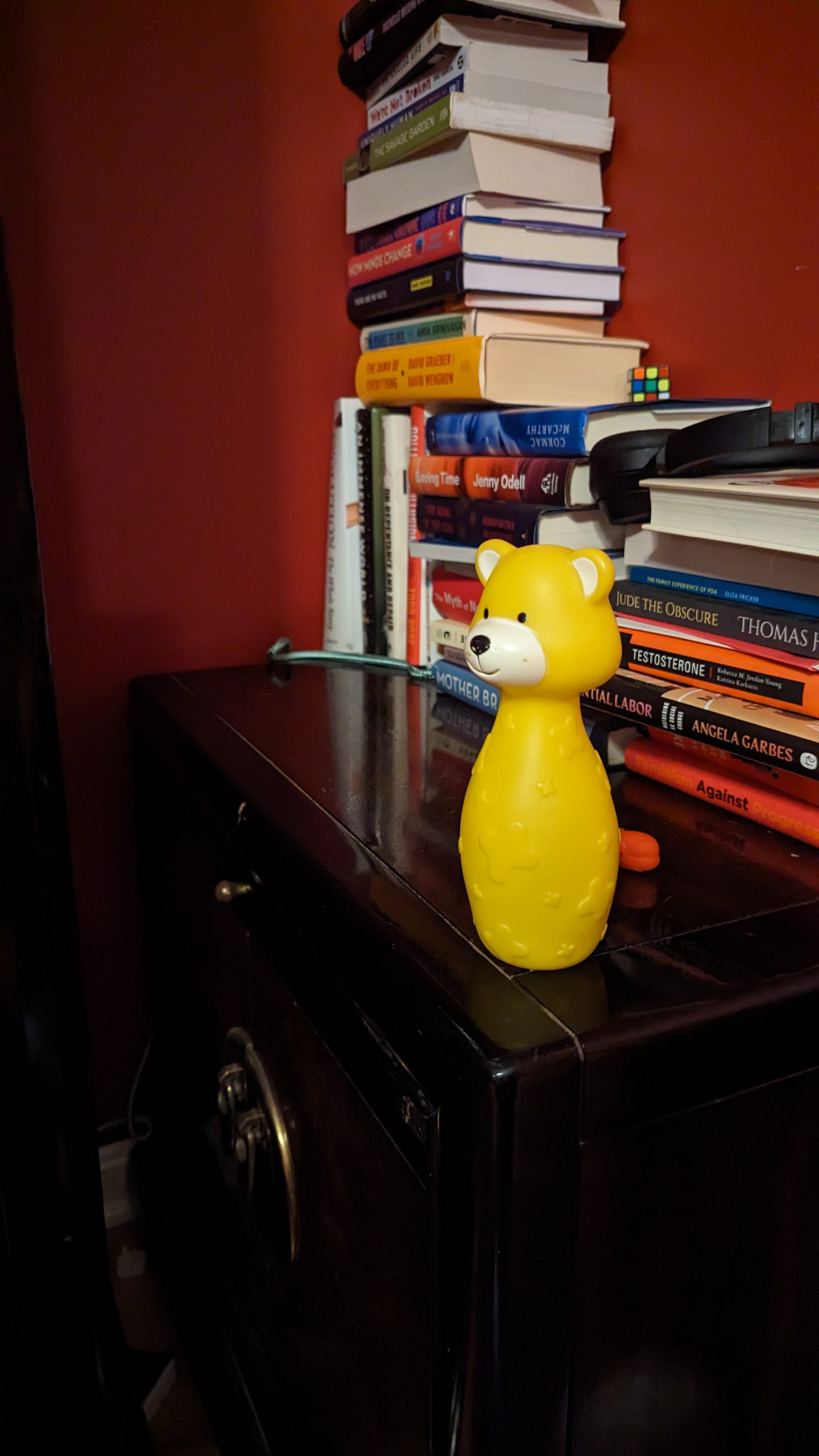What I've learned about Substack success after hitting 10,000 subscribers
Substack enabled me to do what no other platform could. Here's how I took advantage of what Substack offers.
This week, I’m celebrating 10,000 Substack readers. Those are unpaid, not paid, so I'm not going to pretend Substack has made me rich. But as of this writing, my little publication is the 10th most popular paid health and wellness newsletter. Not bad for a feminist blog that pulls no punches and never cozies up to power.
I’ve spent the last 15 years of my career as a writer, but always published my work in other people’s publications. The ability to write what I want, on my own terms, is a dream Substack helped me realize. The fact that I’m accomplishing this with feminist content in a profoundly sexist world is even better.
Substack has truly changed my life. For most of my career, I’ve written about feminism for free, in spite of having a massive audience. I refuse to accept advertisers, or to be told by anyone what to think, do, or say. So I had to make money with other types of writing. When I discovered Substack, I decided to give monetizing my feminism a go, and the results have been delightful. My readers care enough about what I have to say to pay me for it.
I know that some of my readers are also writers, or aspire to be one day. I’m easily frustrated by annoying platforms, so I’m here to tell you that Substack is amazing. I hope you’ll try publishing here, and if you already are, I hope you’ll keep at it. Here’s why Substack is different:
You don’t have to go viral, or have a huge audience, to make money. If you can get a small number of people to believe deeply in your message, you can make real money here.
There’s no AI content bot policing, no forbidden phrases, none of the bullshit that so often gets us in trouble on Facebook, Instagram, and other platforms.
You don’t have to find advertisers! Blessed be.
Write stuff. Get paid. No hitting arbitrary thresholds, or getting paid a tiny pittance, or pleading with editors to pay you. If you get paid subscribers, Substack pays you.
I’m not an Internet marketing expert. I don’t network, or think about SEO (literally at all). I’m not good at self-promotion. The fact that I’ve been able to succeed here in spite of that tells me that anyone who writes well and has a compelling message can, too.
If you’re hoping to get more serious about Substack, here’s what I’ve learned about what works and what does not.
Write something people want to read
This seems like obvious advice, I know. It’s not, and here’s why:
People who view themselves as writers often get caught up in the identity of Writer rather than the service of writing information people want. Rather than putting on a performance of writing well, consider what it is people want to read. What service are you providing?
Are you educating people about a social issue?
Are you teaching people how to solve a problem?
Are you telling an interesting story?
Are you reporting on something happening in the world?
I don’t think there’s a lot of value to wasting time on market research, developing a profile of an ideal reader, or mapping out everything you’re going to do on Substack. But spending a few minutes thinking about what your readers want from you is key. Good writers are empathetic writers. They anticipate their readers’ needs.
Don’t try to please everyone
Not everyone is a feminist. And a lot of people who identify as feminists are not interested in mothers’ issues (making them, to my mind, not feminists at all), or not willing to be as confrontational as I am. Many want to give men the benefit of the doubt, even after centuries of patriarchy.
I am not for them.
I could be for them. Maybe more people would share my articles. More people might even like me, and I bet I’d get less hate mail. But then I’d be boring, and I wouldn’t be offering something unique.
My readers tell me over and over that my unique voice is the reason they subscribed.
My subscribers often tell me that no one else is writing about these issues in the way I do.
It’s not enough to get people willing to read you; you have to offer real value, and speak in a way no one else does.
That means being willing to be disliked. When you don’t care about pleasing everyone, you can speak to the people who really need your message. There’s freedom in making enemies. And in making enemies, you also make a lot of friends. Every writer must take sides, because writing is always about something. Why side with the boring, the conventional, the milquetoast?
Write about something you’re passionate about
I never deal with writer’s block. That’s because I write about something that I am thinking constantly about. I’m passionate about feminism, motherhood, and making a better world for families. Choose something you feel similarly passionate about, and watch the words flow more easily onto the page.
If you’re passionate about something, there are other people who feel similarly passionate. They’ll find you if you’re lucky.
Read about your chosen topic(s)
Good writers read all the time. This is my “currently reading” bedside table (complete with Yellow Bear, the bowling pin whom my baby requires to go everywhere):
Reading more is a passive way to become a better writer. And if you read more in your chosen domain, you’ll come up with more and better ideas, too.
Track your ideas somewhere
Ideas come to me at random. Sometimes I’ll think of a great sentence. Or maybe it’s a series of bullets, a title, or a general topic. The more ideas you have, the more likely you are to lose them if you don’t track them. Carry a notebook and a pen everywhere, or email yourself ideas as they come. You can also use your drafts folder to flesh out ideas. I have 25-50 drafts of content at any given time. I’ve written whole pieces by writing a sentence at a time as ideas come to me. This may work for you, too.
Develop an editorial calendar
Your readers want regular content. Publish on a schedule. If you publish differerent kinds of content, consider lending some regularity to the process with an editorial calendar.
For example, here’s mine:
I publish a free article every Thursday. I also push Feminist Advice Friday through a day early to Substack subscribers, on Thursday.
On Friday, I publish a bonus Feminist Advice Friday for paid subscribers.
I publish a paid bonus on Tuesdays.
On random Saturdays, I publish content that doesn’t fit elsewhere—miscellaneous thoughts on life, tips to be an effective writer, this newsletter.
Write as much as possible without compromising quality
Every writer here is competing with big publications that offer paid subscriptions. If I subscribe to Slate, or to The New York Times, I get access to a ton of content.
You must offer an alternative. Your readers are here because they want something more personal, something that speaks to them more deeply—and something willing to take more risks, without the fear of offending advertisers.
But still, consider the fact that for just a few dollars a month, a person gets access to a whole magazine. My goal has been to make my newsletter its own magazine, with different features, tons of content, and a voice that speaks to people’s darkest and most challenging moments. To do that, I have to publish frequently.
Consider also that every post you write is a chance to gain new followers—a new opportunity to go viral, to hone your craft, to see what works and doesn’t.
Just make sure you’re delivering quality. Readers don’t want to be spammed. If you can churn out a few great pieces a week, you’re doing amazingly.
Create a sense of community
Every niche—whether it’s plants, feminism, or airplanes—includes a devoted group of people who want to talk about their favorite topic. Bring them to your page to talk, and you’ll build a strong and loyal subscriber base. My readers trust my insight. They’re curious about my life. And they like one another.
I publish a monthly Ask Me Anything, and I encourage readers to share their opinions and wisdom. I foster a sense of connectedness, and earnestly care about my readers. You should, too. Otherwise, why should people read the thoughts of someone who doesn’t care what they think?
Build a mix of free and paid content
Free content lures your readers in by showing them what you have to offer. Paid content gets them to invest in you. Offer a balance of each—ideally on a predictable editorial calendar.
I ensure that all of my content is of exceptional quality. But I often put how-tos behind a paywall, because this is the content people are most likely to pay for. I also put everything I write for men behind a paywall, because the people who benefit from sexism should have to pay for my labor.
Listen to your readers
Your readers know themselves best! Answer their questions. Write about the things they say they’re interested in. Reader comments are a great source of additional ideas and feedback.
Be generous
I give free paid subscriptions to anyone who tells me they can't afford it. I'm here because I want to change the world, and I can change more worlds by ensuring women with few financial resources can access my work. Importantly, I don't require anyone to prove they can't afford it, but I do require readers to specifically tell me they can't afford a subscription. I think this mostly filters out the people who can afford it, but who think they shouldn't have to pay.
Don’t use free trials
Substack has a free trial feature designed to encourage more people to sign up for paid subscriptions. I turned it on for several months. What I found is that people signed up for the free trial, unsubscribed when it expired, and then would use it again later to open paywalls. Basically, it functioned as free access to paid content that didn’t seem to encourage real paid subscriptions. Since deactivating it, I’ve had more subscribers and greater subscriber retention. It’s the only Substack feature that I find useless.
Don’t let networking become a distraction
If you wanted to, you could spend all day networking on Substack. Doing so might make you feel like you’re doing something. There are lots of nice, smart people here. But my 15 years of freelance writing have taught me that networking offers the illusion of productivity, not actual productivity.
It’s helpful to get to know people in your niche, to subscribe to other writers (because there are so many good writers here), to recommend content you love, and to ask for help when you need it. Otherwise, though, networking is just spinning your wheels without going anywhere.
I’ve gotten to know some writers, participated in some Substack programs, and integrated the platform into my life. Otherwise, I keep to myself. And my page has grown faster than many of the super-networkers I know. Because ultimately, people are here for the work, not the platform. Which means you need to spend more time on your own work than you do on cultivating platform connections.
Writing is a lonely endeavor. And there’s absolutely nothing wrong with that.




Excellent post! Taking note. My favorite line was about charging men for your labor!
You are absolutely the reason and inspiration behind me moving my work to Substack and I’m eternally grateful. Thank you for the work you do and the way you show up in the world!